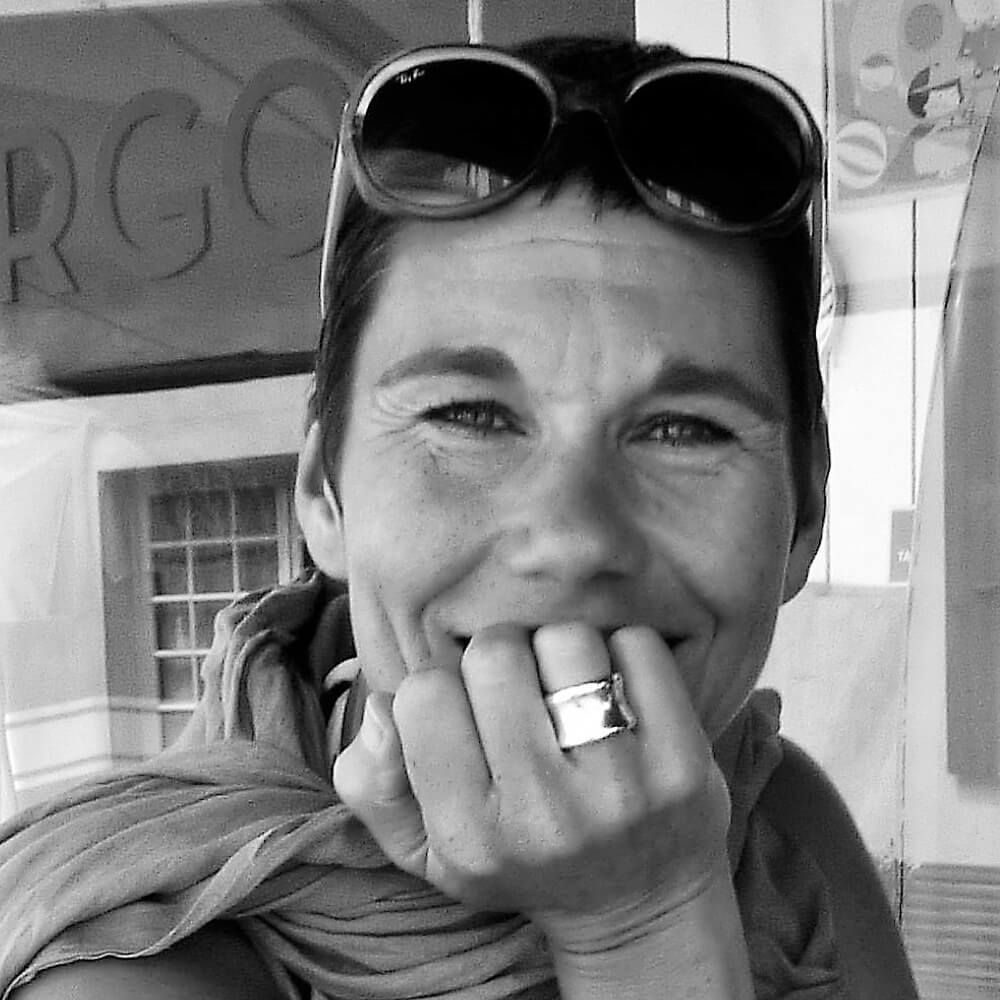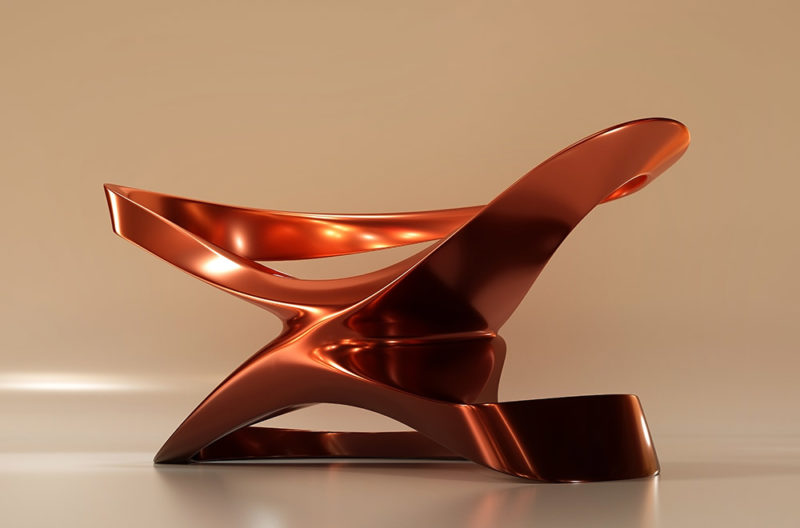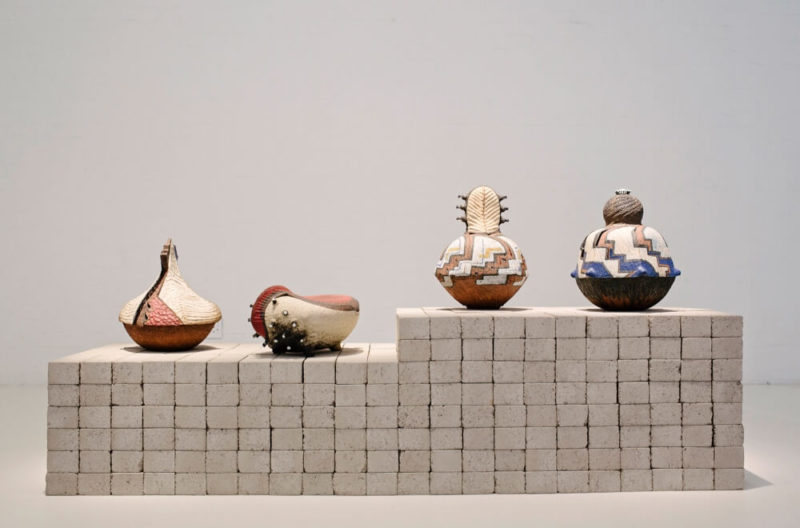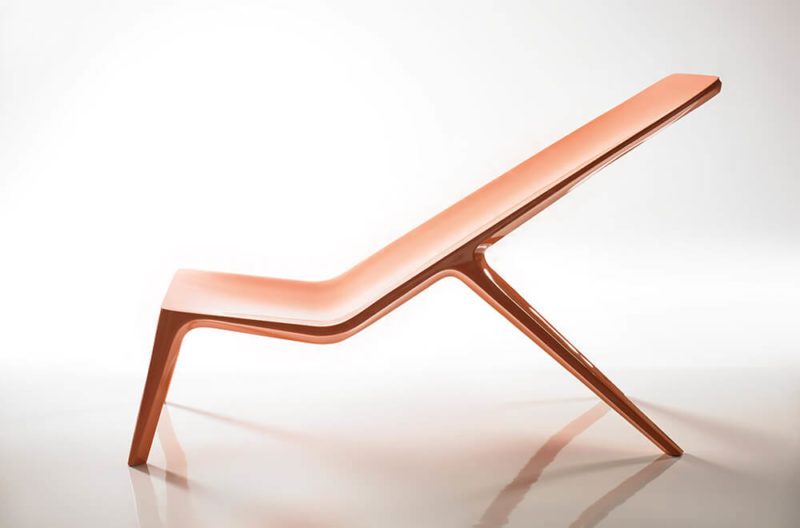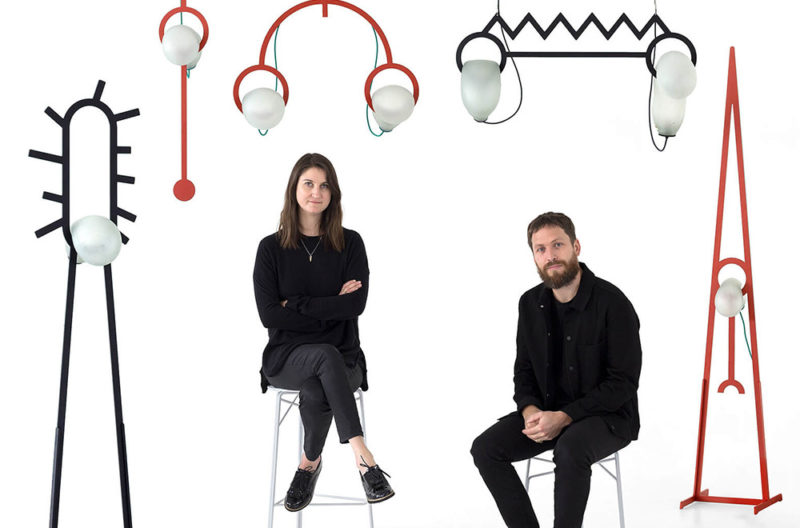Porky Hefer: Plastocene
From the workshops of Cape Town, and now on view in Melbourne, Australia, the South African designer has conjured a world of mutant species, built from the detritus of 21 st century life.
Plastocene – Marine Mutants From a Disposable World
NGV International, St Kilda Road, Melbourne
19th December 2020 – 18th April 2021
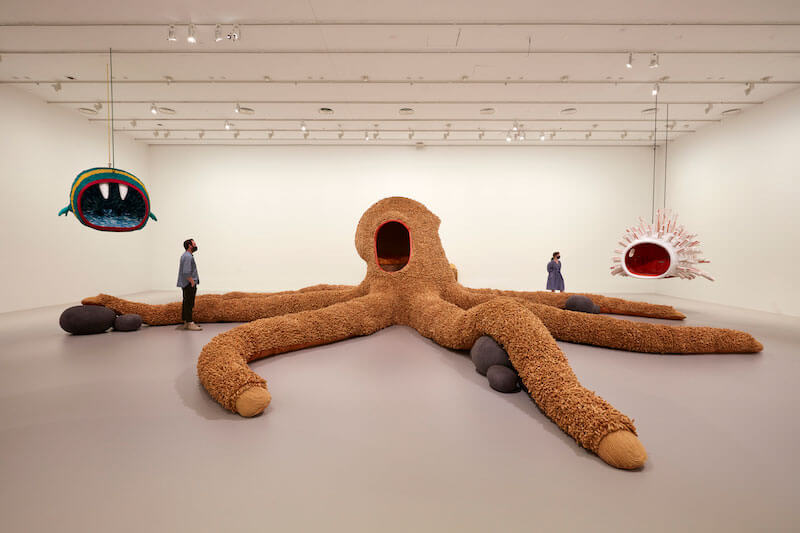
Installation view, Plastocene
COURTESY: NGV / PHOTOGRAPH: Sean Fennessy
WHEN VISITORS TO the NGV Triennial in Melbourne walk into the Porky Hefer room they will be greeted by five super-sized sea creatures. The viewers’ first instinct will, most likely, be to smile; next, they will come closer and be compelled to touch and stroke the familiar forms. And then they will stop because, seen up close, Hefer’s creatures turn out to be far from familiar. They are dystopian mutations. The octopus, ‘Buttpuss’, is made from cigarette butts, albeit ones hand-formed from felt rather than cellulose acetate. It stands at three metres tall, with tentacles stretching to a freakish 15 metres. The brightly coloured striped fish is woven from ghost nets (the remnants of trawling nets which are routinely discarded into the sea) and accessorised with mundane plastic disposables – washing up glove fins, a swimming pool toy tail.
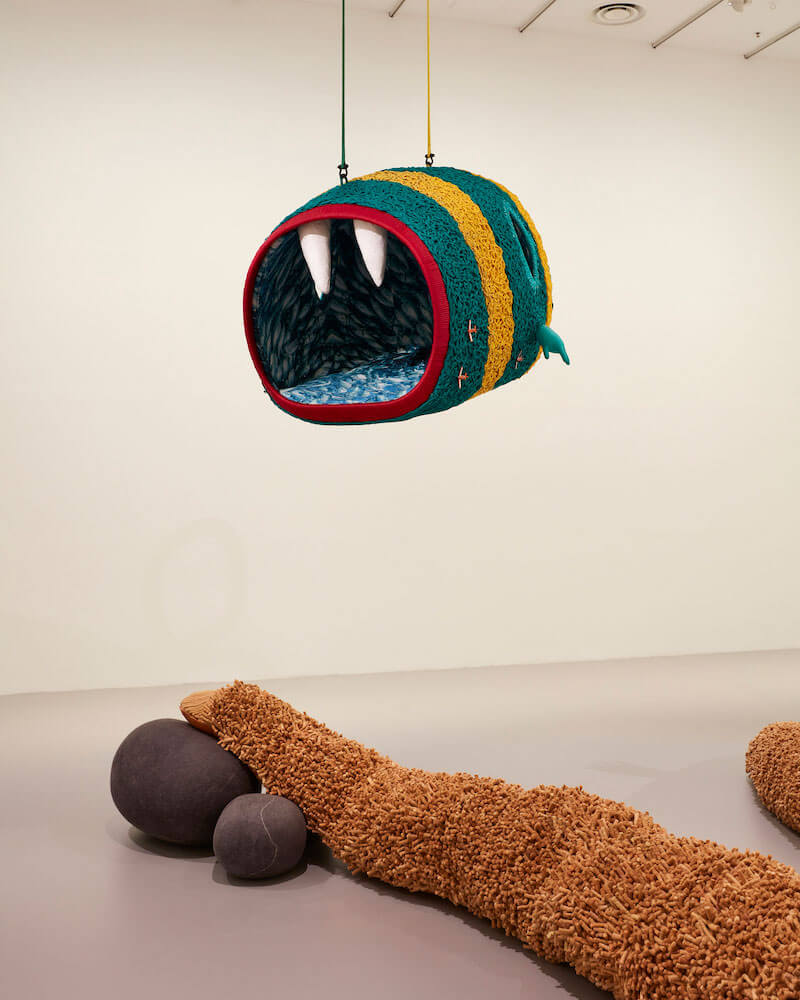
Porky Hefer, ‘Sabre-Toothed Netfeesh’, 2020
COURTESY: NGV / PHOTOGRAPH: Sean Fennessy
This exhibition is called ‘Plastocene – Marine Mutants from a Disposable World’ and each of the five creatures Hefer has made, references a different pollutant. As well as cigarette butts – the single biggest polluter of the world’s oceans – and ghost nets, which account for 10% of the total plastic waste in the sea, there are cotton buds, plastic straws and examples of take away food packaging. In Hefer’s ‘Plastocene’ era, each creature has absorbed so much of its particular poison that refuse and life-form have become one; octopus has metamorphosed into ‘Buttpuss’ and deep-sea fish into a strange new species named ‘Sabre-Toothed NetFeesh’, ‘Suckerfish’, ‘Flat White’ and ‘Q-Tip’.
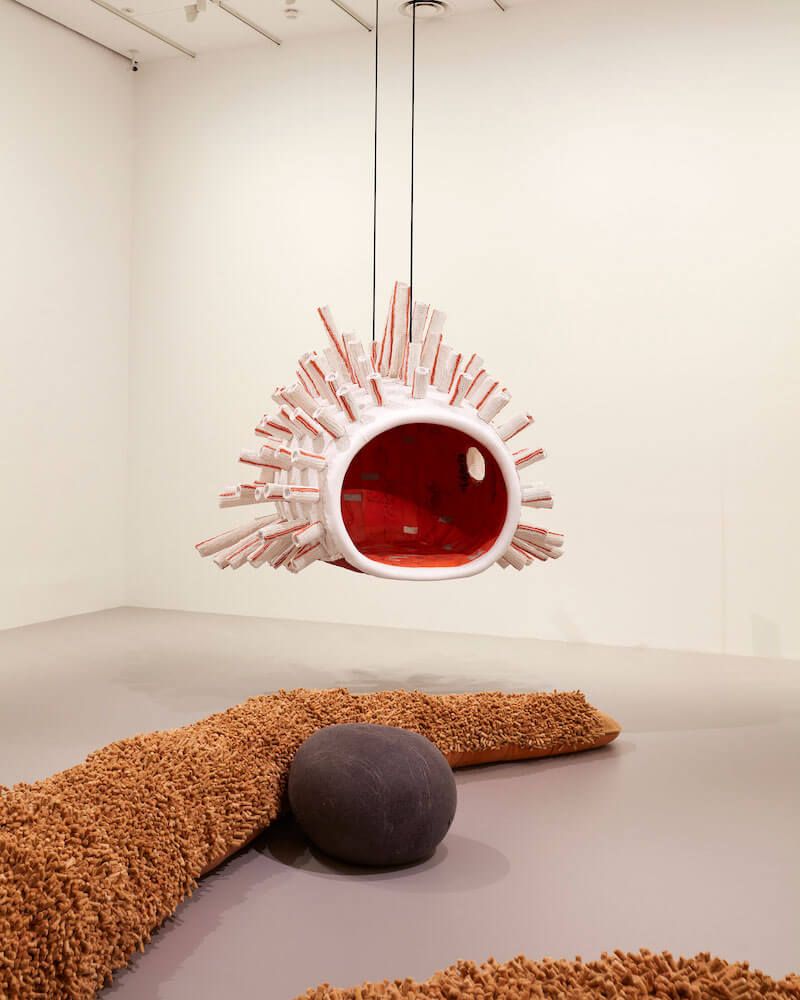
Porky Hefer, ‘Suckerfish’, 2020
COURTESY: NGV / PHOTOGRAPH: Sean Fennessy
And just as these creatures are made to resemble the discarded detritus of hyper-consumerism, convenience and environmental neglect, so too are they made from it – the teeth of ‘Sabre Toothed Netfeesh’ are made from melted down plastic bags and ground sheets. The ingredients of ‘Q-Tip’ include polyester stuffing made from recycled plastic bottles, offcuts from the clothing industry, a damaged carpet, salvaged upholstery fabric and a yacht sail that was en route to landfill.
“I usually mimic what currently exists in the world,” the South African artist explains, “but with this project, I just let my imagination go wild to conjure the world that could be once the human species is eradicated. Thinking about how much plastic is in the seas and how much is ingested by these tiny animals, I began to speculate about what would happen when plastic made up 40% of their bodies. Surely at that point it would become an integral part of their DNA?”
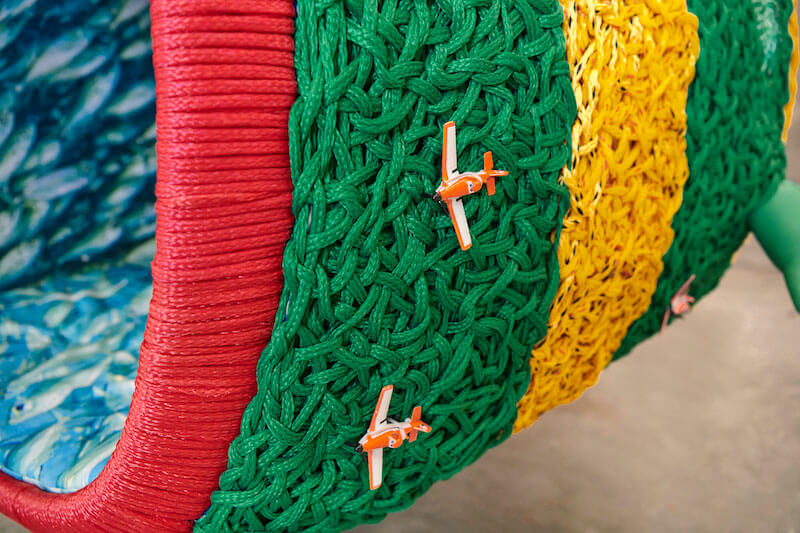
Porky Hefer, ‘Sabre Toothed Netfeesh’, 2020 (detail)
COURTESY: Southern Guild & NGV / PHOTOGRAPH: Antonia Steyn
Hefer’s new works were commissioned by the National Gallery of Victoria (NGV) specifically for the Triennial, an event first launched in 2017 to demonstrate the extraordinary intersection between contemporary art, design and architecture. This year’s edition, which runs from 19th December to 18th April 2021, features 86 projects by more than 100 artists, designers and collectives from more than 30 countries. Amongst the names are many at the vanguard of contemporary practice – American artist Jeff Koons, British designer Faye Toogood, Japanese architect Kengo, Spanish designer Patricia Urquiola, French artist JR to name just a few.
The exhibition is underpinned by four themes – Illumination, Reflection, Conservation and Speculation – and Hefer’s creatures embody them all. They also encapsulate his very particular approach. This former advertising Creative Director, turned artist, is a design agitator – determined to use his work to make us think about the environmental catastrophe we have wreaked, but to do it through positive engagement. “When you’re trying to change people’s behaviour, it’s quite easy to be negative, to shock people by showing them the dead dog,” he says. “But the problem with that is that they don’t do anything after they’ve seen it because you haven’t really shown them how they can participate. I want to inspire people. I want to start a conversation.”
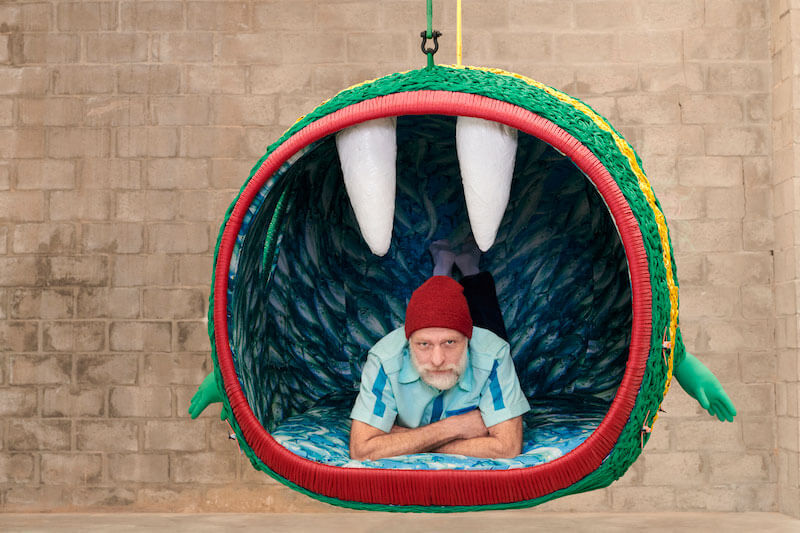
Porky Hefer and ‘Sabre Toothed Netfeesh’, 2020
COURTESY: Southern Guild & NGV / PHOTOGRAPH: Antonia Steyn
Hefer is well known for his anthropomorphic seating environments such the leather crocodile ‘Crocodylus Eugenie’ with its ‘crawl inside me’ jaws and the irresistible, doleful, hirsute ‘Specimen 1’ woven from Kaboo cane, and in these new works too he has deliberately animated each piece in order to engage the viewer on an emotional level. Looking into the horrified face of ‘Flat White’, it is impossible not to imagine the poor mutated creature swallowing the very mug it depicts and making a promise to yourself never to buy takeaway ever again. And of course, Hefer would be delighted if we made that change, but his aim is bigger than that. He wants his work to make us think about our use – and mis-use – of resources in the widest sense.
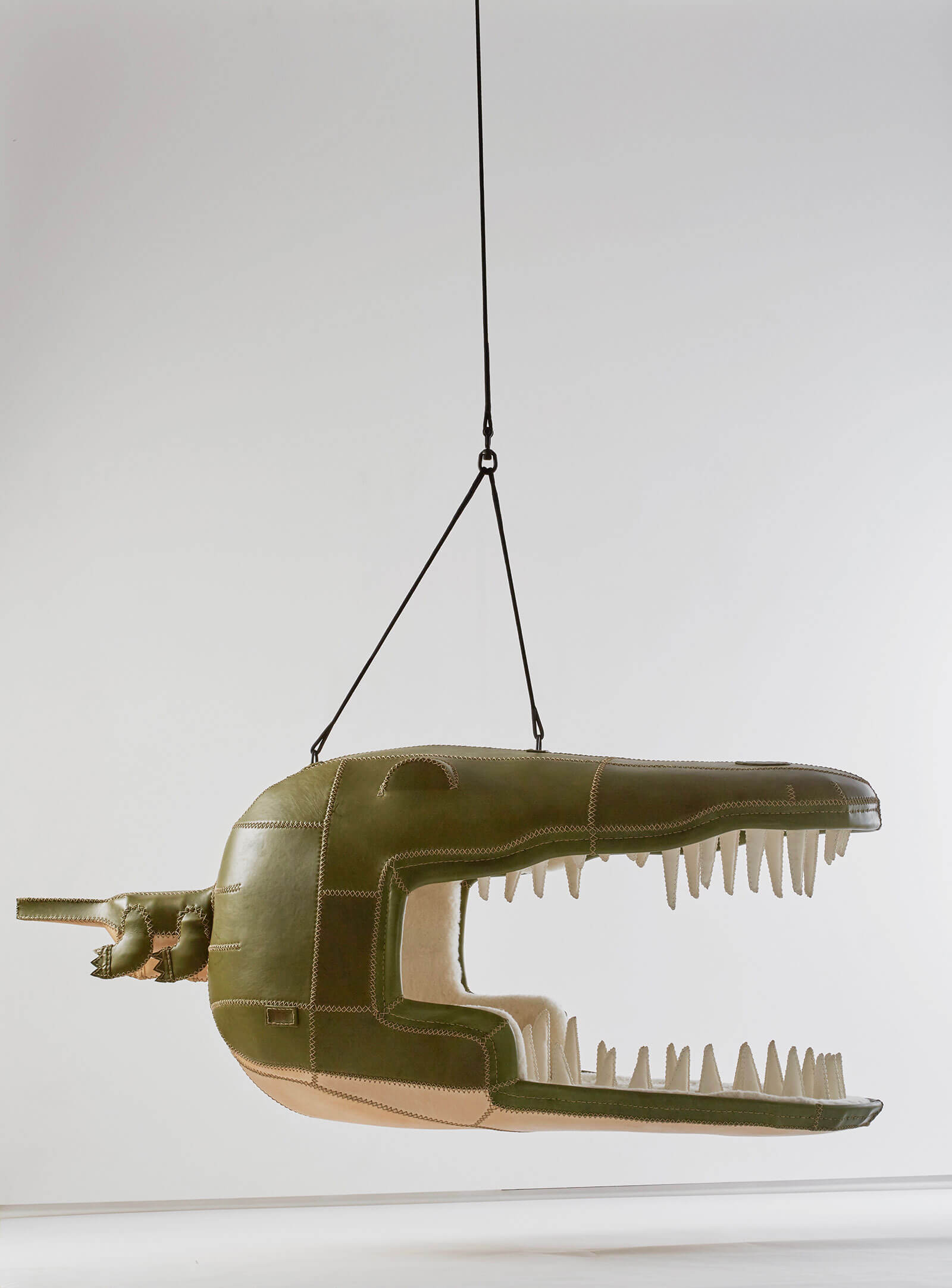
Porky Hefer, ‘Crocodylus Eugenie’, 2015
COURTESY: Southern Guild / PHOTOGRAPH: Justin Patrick
Hefer calls his creative consultancy ‘Porky Hefer – Vernacular Architecture and Design’. The key word there is ‘vernacular,’ by which he means buildings, furniture and objects made from local materials by local people using local techniques. “Vernacular is, I believe, the future of the world,” he says. “Local materials are at hand and are acclimatised to the environment, while using techniques familiar to people in the area means that it’s easy to find helpers to work with and also provides support to local economies.”
His award-winning building ‘The Nest’, a development of the nest seating environments he has been making for over a decade, is the largest example of this principle in practice. Commissioned by the naturalist Swen Bachran on the Namib Tsaris Conservancy close to Sesriem in Namibia, the gently domed thatched roofs of ‘The Nest’ are made from reeds gathered from along Zambezi River, the walls are made from handmade bricks clad with granite dug from the site, and the furniture was made by local artisans. Even the building’s inspiration, the sociable weaver bird, was local.
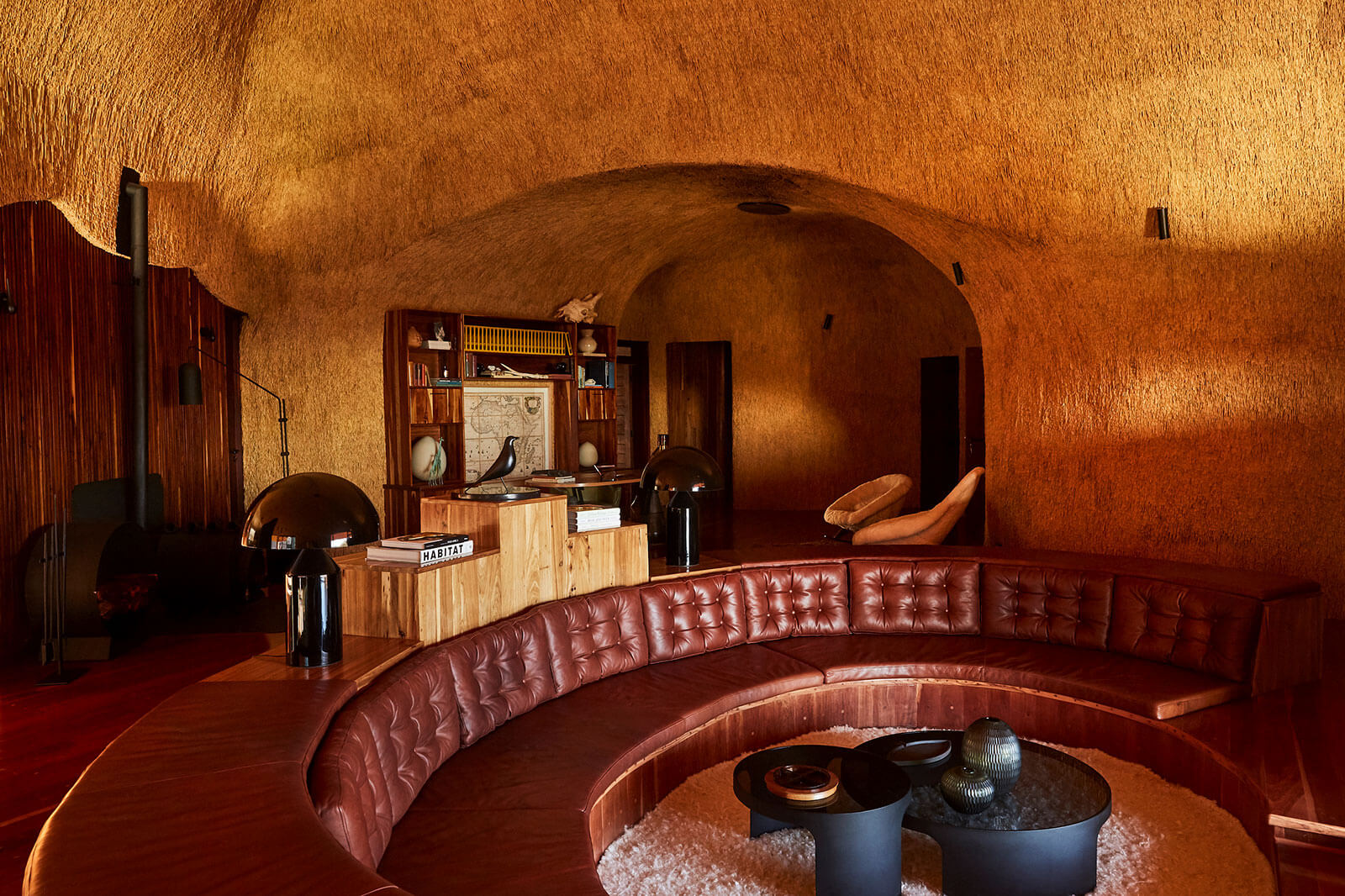
Porky Hefer, ‘The Nest’, 2019
COURTESY: Southern Guild / PHOTOGRAPH: Katinka Bester
‘The Nest’ appears to grow out of the earth, so discreet that the local wildlife uses the swimming pool as a watering hole. Hefer’s ‘Mutant Creatures’ sit more obviously in their surroundings, but they are no less vernacular. Hefer does not have his own studio, preferring to work collaboratively, using the skills that are readily available indigenously. For the Plastocene exhibition, which was facilitated by Southern Guild, the Cape Town-based gallery that represents him, he worked with more than 80 craftspeople drawn from six studios across the city. The thousands of African Karakul wool ‘butts’ which cover ‘Buttpuss’ were laboriously rolled, soaped, twisted, shrunk and dyed by artisans working with felt designer Ronel Jordaan.
The meticulous leather work of ‘Flat White’ is by sustainable leather makers Wolf & Maiden Creative Studio, while the craft enterprise Mielie made both the giant pom-poms that cover the interior space of ‘Q-Tip’ and the spikey exterior of ‘Suckerfish’. For the latter, a group of township-based women, employed by Mielie, crocheted masonry twine into 150 individual straws, each of which was then shrunk and dipped in resin before being stuck into the fish’s bulbous body. The creature’s vivid interior was made by the Studio’s lead seamstress, Zanele Sinuka, from disassembled, out-of-date life-jackets.
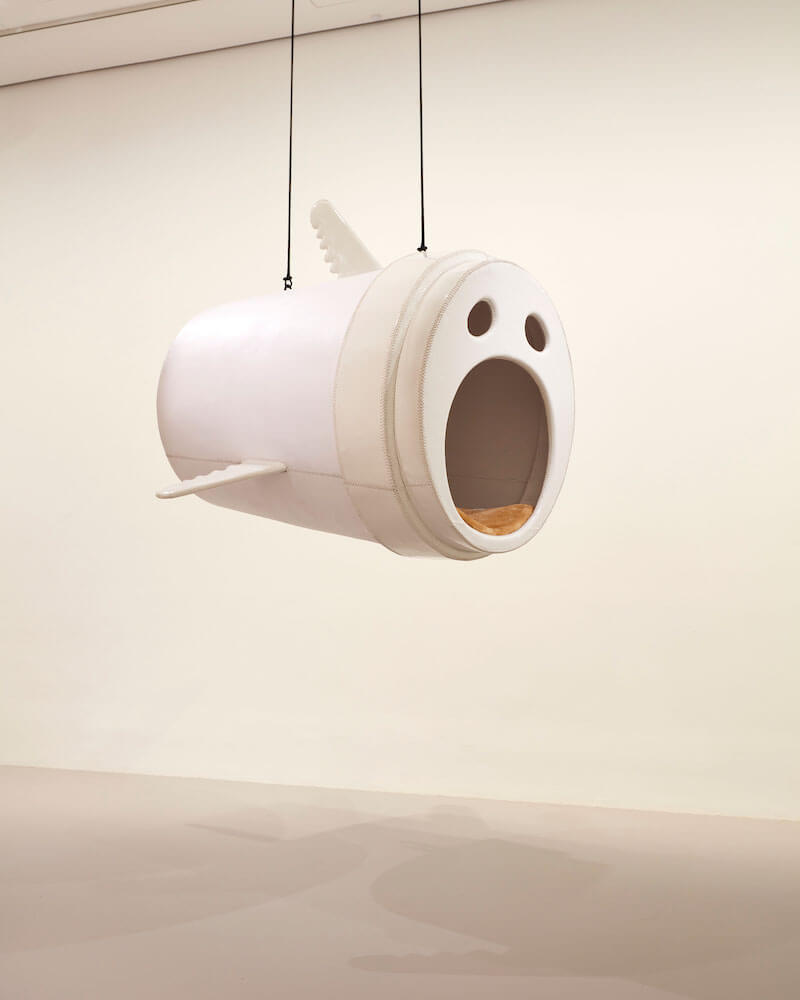
Porky Hefer, ‘Flat White’, 2020
COURTESY: NGV / PHOTOGRAPH: Sean Fennessy
This collaborative, make-by-hand approach is, in part, simply practical. “I like not to use machinery,” Hefer explains, “because machinery needs specifications and it’s difficult to give specifications for something that doesn’t exist. I don’t do computer drawings and I don’t make maquettes or models. My making process is more about an idea – I do a little sketch and then I find the artisans to help me work it out. It’s easy to find the skills here because South Africa is still a country where people know how to make things … it still has craft in its DNA.”
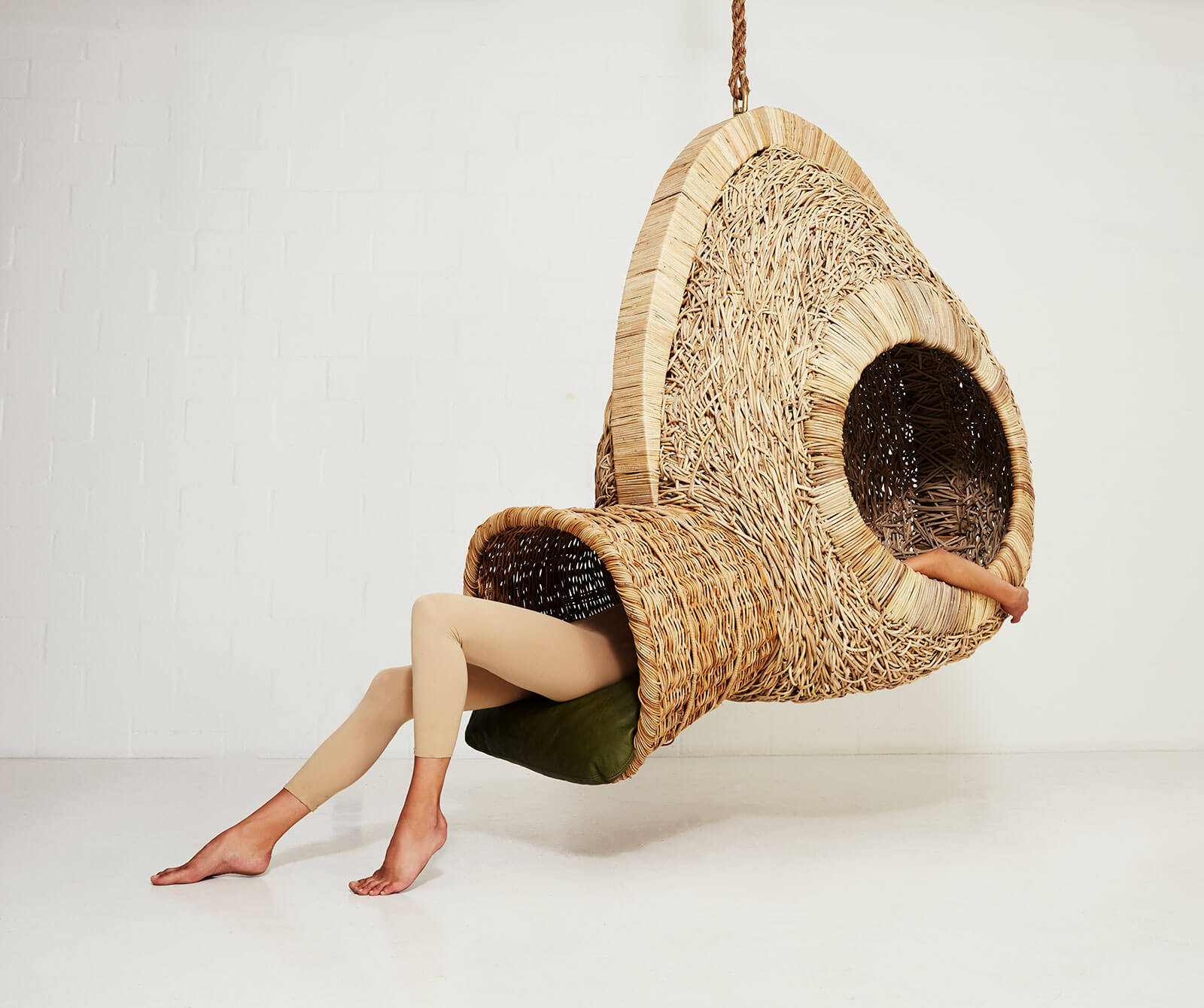
Porky Hefer, ‘Bwa Leaf Mask’, 2016
COURTESY: Southern Guild / PHOTOGRAPH: Rudi Geyser
But his dedication to the hand-made and the local is also political, a result of growing up as a white person in South Africa. “It takes a lot to right the wrongs of the past, especially around apartheid and what apartheid has done,” Hefer, who was born in 1968, says. “We are nowhere near fixing it, but there is an extreme level of consciousness now and that’s the right place to be. We need to give a lot. For me, working with South African craftspeople is a way of showing them that there is a living to be made in the skills they have.”
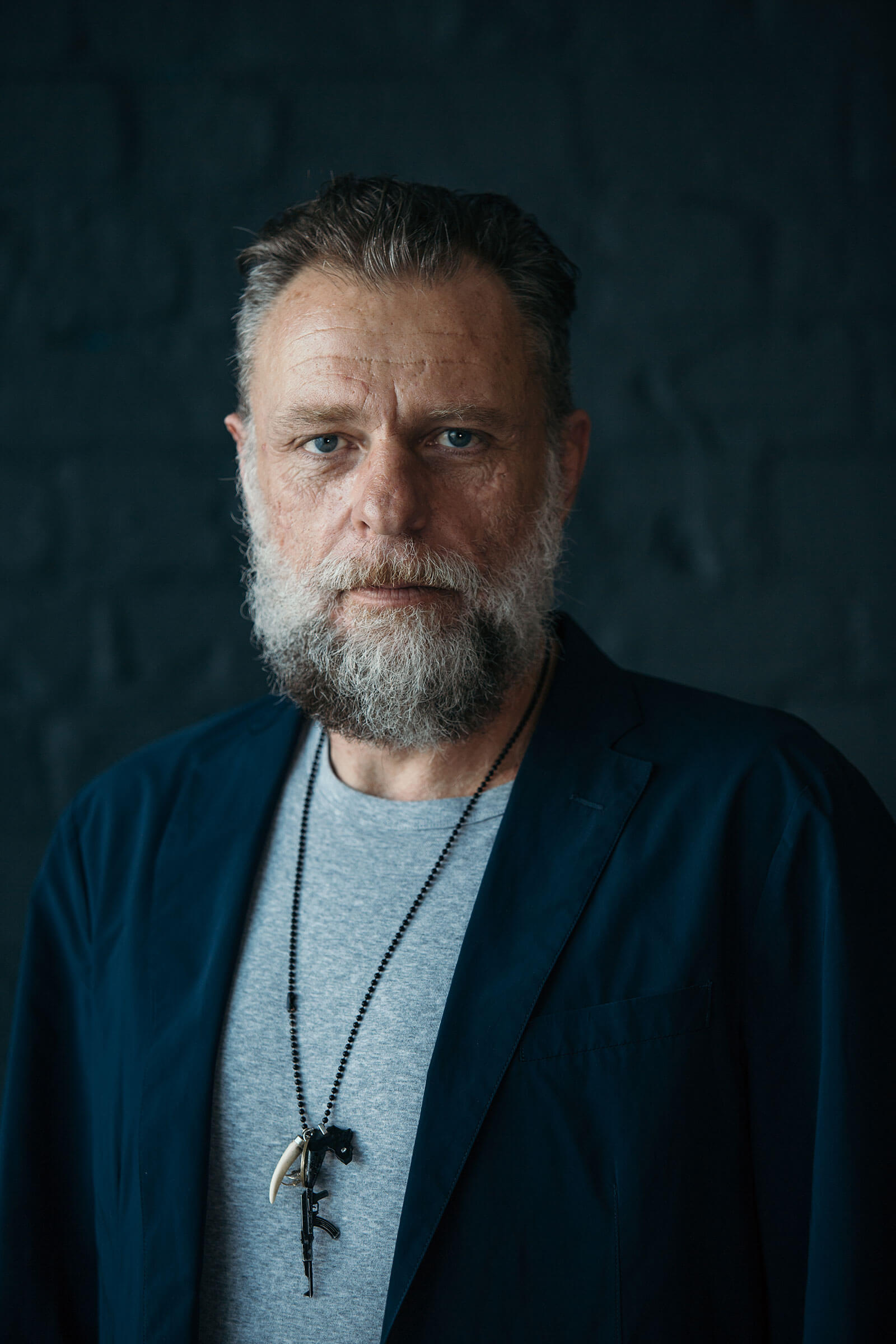
Porky Hefer
COURTESY: Southern Guild / PHOTOGRAPH: Steve Marais
Hefer selects the craftspeople he collaborates with carefully, consciously seeking out companies and organisations that mandate education, upskilling, equality and employment opportunities for the marginalised. By focusing on hand rather than machine-making, he can spread the work across many people, thus creating a dispersed system of making that provides at-home employment for women who would otherwise have to choose between raising a family, or looking for work.
Tony Ellwood AM, Director of the National Gallery of Victoria describes the Triennial as offering visitors “a significant opportunity to explore how we use art to express ourselves, communicate and consider the world as it is, while also asking how we would like it to be.” Hefer’s vision of the creatures that will inhabit his post-Anthropocene Plastocene era might be dystopian but, through both the method and repurposed materials of their making, they also offer a positive message about how craft and localism and collaboration can be drivers of both social empowerment and environmental action.
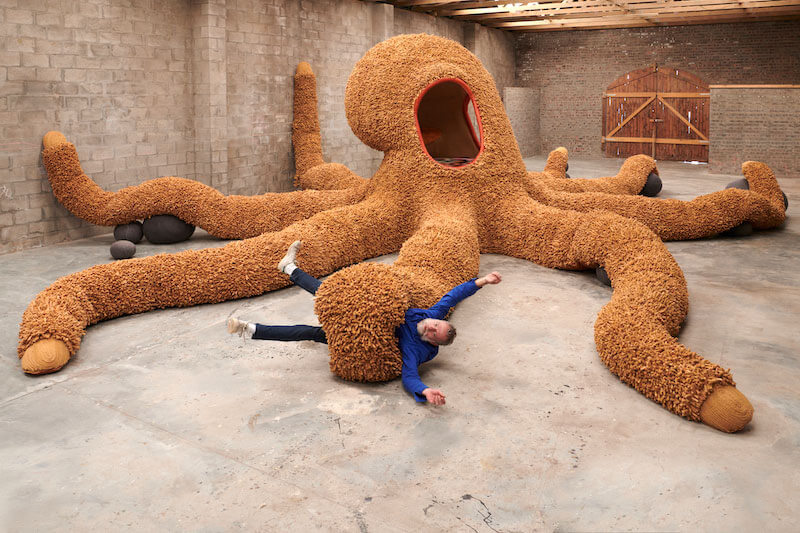
Porky Hefer, ‘Buttpuss’, 2020
COURTESY: Southern Guild & NGV / PHOTOGRAPH: Antonia Steyn
Porky Hefer is represented by Southern Guild, Silo 5, Silo District, V&A Waterfront, Cape Town.
